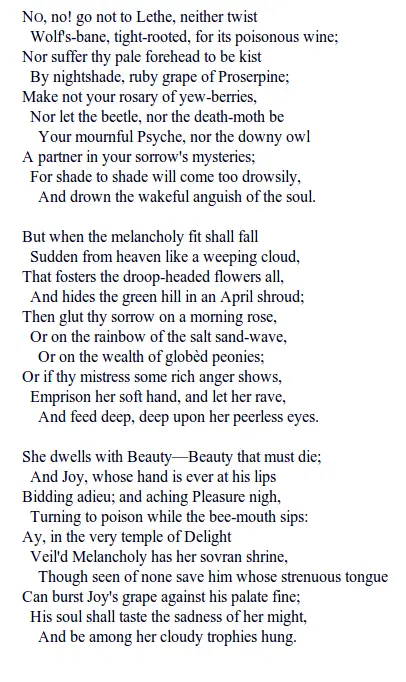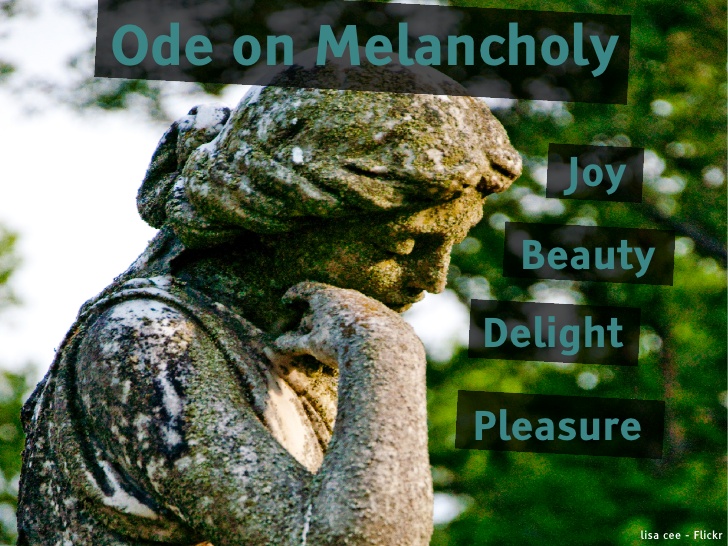“Ode to Melancholy” is one of his famous works which was published in 1819 along with “Ode to the Grecian Urn”. This poem is written in three stanzas and each contains ten lines.
Table of Contents
Ode on Melancholy Rhyme Scheme
This poem is written in iambic Pentameter and the rhythm scheme is “ababcdecde”. Not only this poem most of the Keatsian poems are written in this pattern. According to critics, this is a Keatsian style of writing.
Ode to Melancholy Theme
“Ode to Melancholy” is a perfect romantic dialect that is showing the mourning heart of the beloved. The theme of the poem is melancholy.
In the whole poem, the poet addresses the melancholy for love and nature. Though any straight motif can not be found in the whole poem. Sadness, mournful heart, and melancholy is the primary theme that is being shown.
Ode on Melancholy Detailed Summary and Analysis
In the very first lines poet says not to go to the ‘Lethe’ and not to make any twist won the cursed wolf that is related to Greek mythology as it has its poisonous wine.
So the first two lines are very much historical and the term ‘Lethe’ refers to Greek mythology. Again saying not to suffer from the pain of a kiss that was given in a pale forehead.
Ode to Melancholy Full Text

“Nor suffer thy pale forehead to be kiss’d”
Poet is uttering to someone to avoid the cursed history of Greece and here, saying not to let the rosary berries grow over the yew. Again poet is saying not to let the beetles grow even nit the dead moths.
Now Keats is taking several imageries of ‘mournful psyche’ and ‘downy Own’. These are used to open the deep emotion of the poet that he is annoying.
“A partner in your sorrow’s mysteries;”
This line prefers that the partner will try to find the mystery of the suffer and from the shade of darkness a deep sorrow will reach and the wakeful hell like anguish will drown of the soul.

So, the first paragraph ends here with fragmented thoughts. The readers can not get the exact thing that Keats is trying to say. The second stanza starts with the line,
“But when the melancholy fit shall fall
…like a weeping aloud,”
Here the poet is enunciation that when the melancholy will fit and fall some water from the eyes will come and suddenly from heaven it will start weeping out.
The fosters that were taking care of the flowers will leave and this shining flowers will droop again. And the flowers will hind the green hills in an ‘April shroud’. Again seasonal imagery comes out in the poem as in the “Ode to Autumn”.
The sorrow will be gone and the rest flowers will grasp them. Or the salt sand waves will be seen in the rainbow. Or if the mistress shows anger then the poet will imprison her soft hand by his arms and the poet will let her rave.
Ode to Melancholy Poem
When the beloved will show her anger the poet will look at her peerless eyes. Again romantic imagery comes in the poem. Poet says to look at her eyes and will fall in love.

In the third paragraph poet starts with the explanation that,
“She dwells with Beautiful-Beauty that must die”
Here, suddenly Keats changes his motif from mournful thoughts to beauty and love. She, the beloved will live with her beauty that will die once and the joy will also arrive because the hands of the beloved will stay at his lips.
Ode on Melancholy Metaphors
She will bid the poet and will ache of the pleasure night that they have to spend. This line is mold with romanticism. Then Keats is saying he will turn to the poison that a bee mouth sips and will utter of the delight.
After that, her mourning heart will be seized by the servant shrine.
“Though seen of none save him whose
Strenuous tongue”
In this line, Keats utters that none was seen to save him who has a ‘strenuous tongue’ that will be burst in the joy that lies against his fine palate.
Ode on Melancholy Interpretation
The soul of the lover will taste the sadness that was within the soul of the beloved and it will be staying among her cloudy trophies that are being hung. This is the whole poem written in Keatsian dialects. This is a perfect example of romantic poetry.
Rhetorical devices
In this poem, Keats uses several rhetorical devices to attract readers. Syncope, Alliteration, Anaphora, enjambment, imagery, etc.
First comes Syncope, which means writing a word using apostrophe like, ‘kis’d’, ‘veil’d’.
Then comes Alliteration, it addresses the repeated of words starts with the same vowel sounds one after another like,
“with Beauty-Beauty that must die;”
Anaphora is also a rhetorical device that means repetition of a word in the starting of lines one after another like,
“Or on the rainbow of the…
Or on the wealth of gloved peoneis;
Or if thy mistress some rich…”
Enjambment is the continuation of thoughts in the next segment in the poem. Here Keats uses this in the last of the second stanza to last stanza.
“And feel dep, deep upon her peerless eyes.
She dwells with Beauty-Beauty that must die;”
Not only that there several imageries like, ‘bee-mouth sips’, ‘poisonous wine’, ‘mourning rose’.
Frequently Asked Questions
What does Ode on Melancholy mean?
Ode is just like a song that is being written in the form of a poem that tells a story. Ode to Melancholy means a song of sorrow or sadness.
How does Keats address melancholy?
Poet addresses melancholy as of the beloved and nature’s.
What type of poem is Ode on Melancholy?
This is a romantic poem.
When was Ode on Melancholy written?
It was written between 1817 to 1819.
What does melancholy mean?
Melancholy means a deep sorrow.
What’s the meaning of Ode?
Ode means a tale or a song that has been written in the form of a poem.
What is the example of an Ode?
“Ode to the Westwind” is an example.
What are the three types of Odes?
Pindaric, Horatian, and Irregular are three types of Odes.
